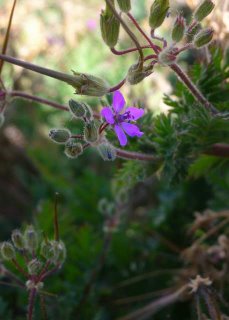 What’s blooming in the area: A few blanket flowers survive along my neighbor’s drive. Leaves dropping, cottonwoods and apples turned brown or bare.
What’s blooming in the area: A few blanket flowers survive along my neighbor’s drive. Leaves dropping, cottonwoods and apples turned brown or bare.What’s blooming in my garden: Fading chrysanthemums, sweet alyssum vital in porch pot.
Animal sightings: Nothing when I’m looking.
Weather: Clear days, bright stars, no moisture since 15 October.
Weekly update: Something purple was blooming on dense, ferny plants at my neighbor’s fence last weekend.
The five petaled flowers splayed in loose round umbrels and long, tapering seed capsules looked like something from the geranium family. Field guides tell me it could be Erodium Ciculatium, which goes by the not-so common names Filaree, Pin Clover, and Red-Stemmed Filigree. Europeans call it Common Cranesbill.
How it got to my uphill neighbor’s yard is guesswork. Spain introduced the Mediterranean annual to México and Chile. Mensing and Byrne analyzed pollen in Santa Barbara basin sediments to show it reached California at least a decade before the missions, and probably crept north from Baja. It could have landed here with settlers anytime after Oñate wintered north of town in 1589, or diffused from settlements and missions to the south.
The migration mechanism is simple: cranesbill’s sharp carpels stick to passersby, especially furry ones. Today it’s not only grazed by cattle and sheep, but mule deer, elk and pronghorn. Rabbits clear room when they gnaw competing perennial grasses. Deer or rabbits could have been the exozoochoric agent that moved seeds before cattle or sheep escaped.
Once in the soil, the desert colonizer germinates whenever daily air temperature ranges are warmer than 40 to 69 degrees, and there’s enough moisture. This summer it was blooming in my neighbor’s yard August 16, some forty days after the first summer rains. It adapts to drying soil by accelerating its maturation cycle to produce seed quickly, again as it has done next door where it’s blooming in the fall, rather than wintering over and blooming early next year.
How the seed moved from someplace like Anadalusia or Estremadura is more speculation. Most historians assume it was accidental, that it came with the food or accouterments of animals, might even have been in the wool of sheep. Others suggest the 1/16"-1/8" elliptical, brown seed could pass for wheat.
If instead the importation was deliberate, it might have been for medicine. Curtin found alfilerillo used for gonorrhea in Northern New Mexico in the 1940s. A contemporary Argentinian herbal suggests it’s useful for blenorragias, roughly translated as female gonorrhea. In 1987, Polish scientists established it is effective against Herpes virus type 1.
Modern herbals usually repeat it’s hemostatic, but Lust specifies storkbill’s uses for bloody uterine discharges and excessive menstruation. Gohar reports it has been used to induce uterine contractions, while a northern Mexican herbal explicitly suggests the leaves induce abortions.
Sexually transmitted diseases and female problems, whatever that euphemism denotes, certainly existed for early colonists, and familiar yerba seeds would have been brought by women who became curanderas. The French still call it peine de la bruja (witch’s comb.) More than likely, such things would not have appeared in records kept by literate priests or administrators.
All of which is interesting, but doesn’t much explain why its growing next to my drive. Since it often stays low, especially if it’s cropped or mown, and the flowers open mid-morning, it could be lurking along the road unseen. More likely, my previous neighbor imported the seeds with his wood pile or horses’ hay.
If it’s true a single plant can produce 2,400 to 9,900 seeds and its deep taproot deprives its neighbors of water, I hope my neighbor overlooks it and lets it multiply to intimidate the nastier pigweed and Russian thistle that thrive on his land.
Notes:
Argentina. "Alfilerillo," at Hipernatural.com.
Curtin, L. S. M. Healing Herbs of the Upper Rio Grande (1947), revised for Western Eagle Press by Michael Moore (1997).
Gohar, Ahmed A., Mohammed F. Lahloub, and Masatake Niwa. "Antibacterial Polyphenol from Erodium Glaucopyllum," Zeitschrift für Naturforschung 58:670-674:2003.
Lust, John B. The Herb Book (1974).
Mensing, Scott and Roger Byrne. 1998. "Pre-Mission Invasion of Erodium Cicutarium in California," Journal of Biogeography 25:757-762:1998.
Mondragón Pichardo, Juana. "Erodium cicutarium (L.) L'Her. ex- Ait.," 2004, revised by Heike Vibrans, 2005, available on-line..
Zielinska-Jenczylik J., A. Sypula, E. Budko and H Rzadkowska-Bodalska H. "Interferonogenic and Antiviral Effect of Extracts from Erodium Cicutarium," Archivum Immunologiae et Therapiae Experimentalis 35:211-20:1987.
No comments:
Post a Comment